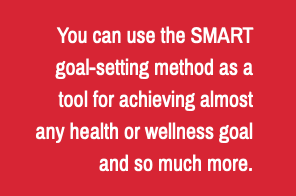Payroll Update
By Paul Parkinson, Director, Finance
With spring just about here, I read a very interesting article that translated a common tool we use in the finance area. The tool is the setting of SMART goals. The article focuses on exercise, so I thought it would be a great opportunity to share this as we’ll be getting to the warmer weather soon. The article was published by LifeWorks, ASP’s carrier for employee assistance programs and more.
SMART Goals and Exercise
Having clear, short-term goals is like having a road
map, and that can be an important part of success when developing an exercise routine. Whether you work with a health coach or prepare for a healthy change on your own, the SMART-goal model can help you think through and evaluate your plans.
What Are SMART Goals?
Smart
Is a method of goal setting that focuses on short-term, practical tasks to set you up for success. Breaking down large goals into smaller incremental goals is important for long-term achievement and sustainable behaviour change. SMART stands for:
Specific
A goal needs to be well-defined and clearly worded in a positive statement. It should be narrow enough in scope to use as a guide.
Measurable
Your goal should be specific and measurable so that you have a way to track your progress and identify when success is attained.
Action-Oriented
You are more likely to achieve your goal if it includes steps you will take. That’s why the “A” can also stand for achievable or attainable.
Realistic
Goals motivate us to grow and challenge ourselves, but they need to be realistic—and relevant. If your initial goal is realistic and relevant, it can help you move forward with more confidence in achieving other goals. If you want to begin eating healthy, start by introducing healthy foods slowly into your diet each day, rather than going on a crash diet.
Time-Bound
You’re more likely to reach a goal if it has a timeline in which to accomplish the goal. Creating a timetable makes it easier to measure your progress because it gives you a clear target and helps you stay focused.
While SMART goals are very specific by design, try to focus on their intent, and know that the actual goals might need to be modified along the way.
How to Apply SMART Goals

Your goals will ideally build on your past successes and experiences. Think about what has and hasn’t worked in the past and what might need to be different this time.

For example, if running for 30 minutes every day of the week was not sustainable for you, a new SMART goal could involve going for a 20-minute walk or run four times a week.
Here are a few examples of how SMART goals can work for someone who wants to develop an exercise routine:
- Starting tomorrow, I will walk 20 minutes during my lunch break at work Monday, Wednesday, and Friday for the next two weeks.
- Starting tonight, I will ride my exercise bike for 15 minutes while watching a TV show at least every Monday and Wednesday for the next three weeks.
- Starting tomorrow, I will attend a 30-minute online fitness class on Tuesdays and Thursdays for the next four weeks.
- Starting today, I will do 10 push-ups and 10 squats before breakfast and before dinner Monday, Wednesday, and Friday for the next two weeks. It’s vital to write down your goals, action steps, measurements, and time frame. You may find it helpful to keep a copy of the week’s goal with you or in a convenient place where you can refer to it easily. Focus on being consistent and patient as you wait for results. Review your goals frequently to make sure they still match your bigger plan and modify them as necessary. If your goal didn’t work out as planned, that’s OK. You can create new goals that better match your circumstances or implement a strategy to make the goal work better. If you exceed your goal or do better than expected, you can enjoy celebrating your additional success. Reward yourself for any goal you achieve, regardless of how small or large it is!
